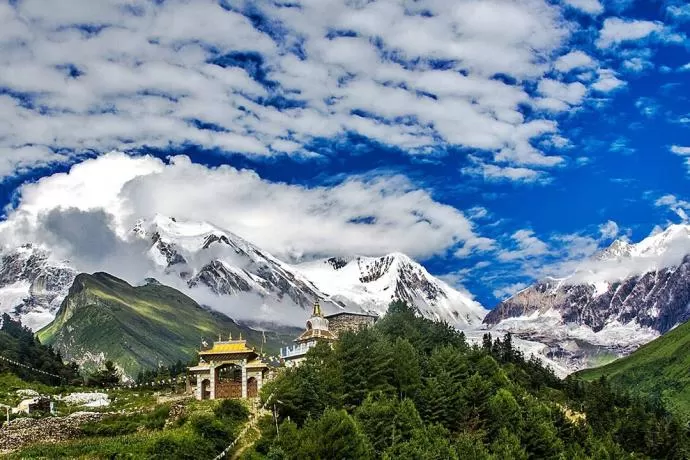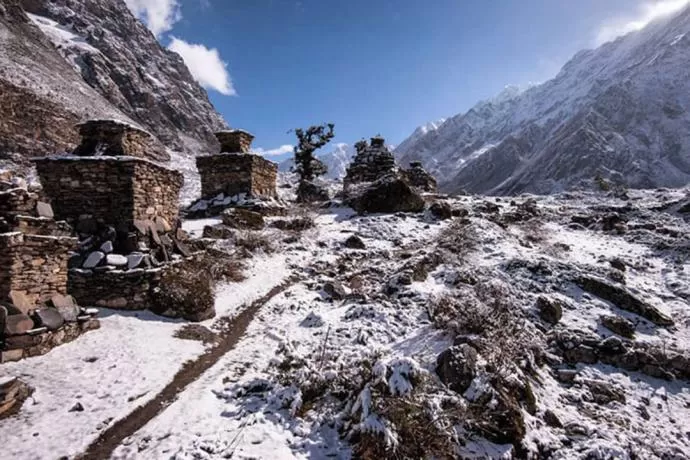Manaslu Circuit Trek
The Manaslu Circuit Trek is a stunning trekking adventure in the remote Manaslu region of Nepal. The trek is also listed as one of the restricted areas, taking you around the majestic Manaslu Mountain, the eighth-highest peak in the world.
Offering breathtaking landscapes, remote villages, mountain views, and a glimpse into the rich local culture, the main highlight of the journey comes as you cross the Larkya La Pass, standing at an altitude of 5,160 meters.
The trek is physically challenging with over two weeks of length, but it rewards you with the raw beauty of the Himalayas and experience in the region's serenity.
To complete this beautiful journey that combines adventure, natural beauty, and cultural richness, you can choose from several trails and customize the itinerary accordingly.
We present you with the best packages for the Manaslu Circuit trek. You can either complete the trek with the usual itinerary or undertake more challenges by adding more destinations.
As our top priority is the preference and safety of our clients, our devoted team guarantees your comfort and safety throughout the journey, offering you an experience of a lifetime.
Traveller Photos for the Manaslu Circuit Trek
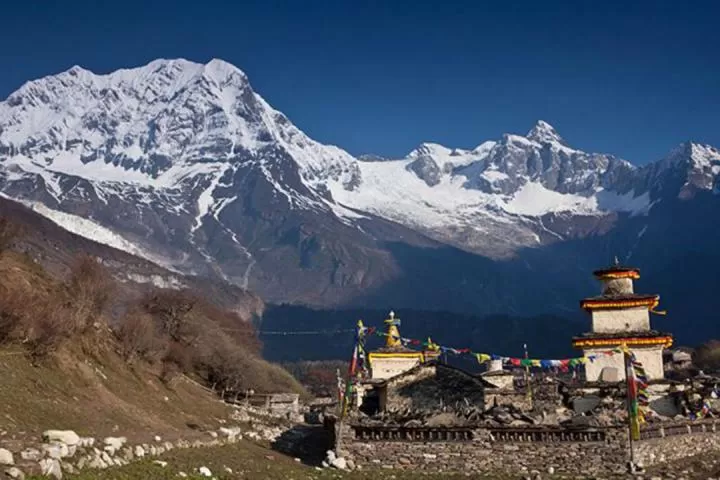
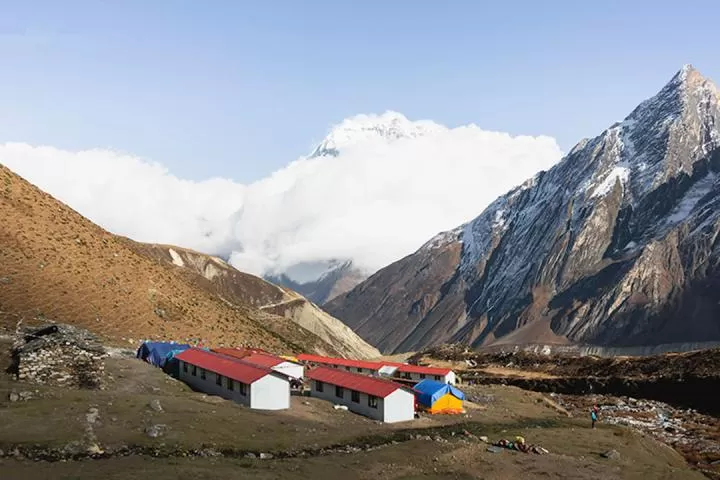
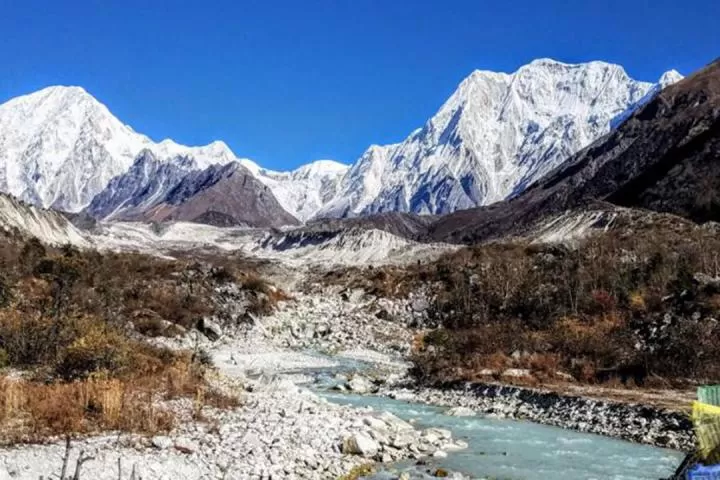
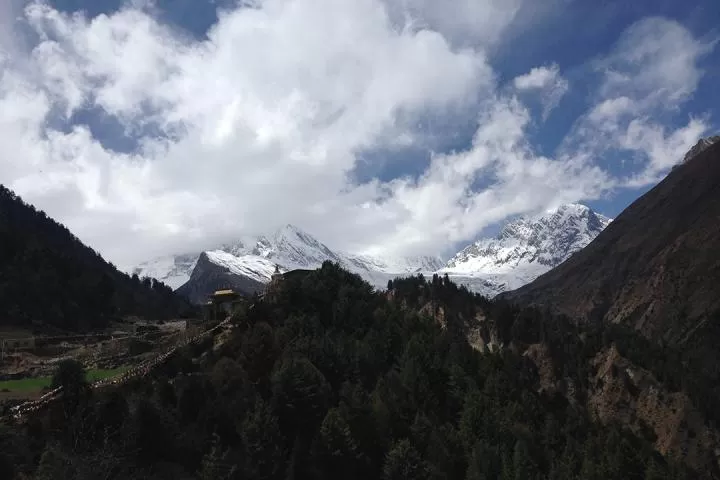
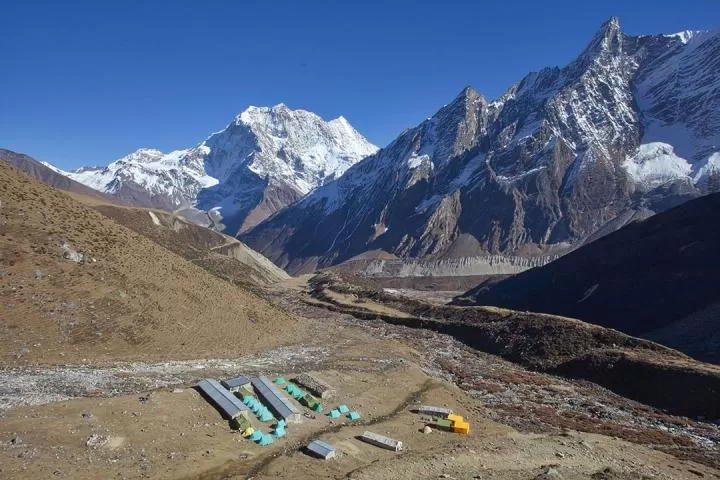
Manaslu Circuit Trek - Overview
Location: Manaslu Conservation Area, Nepal.
Duration: 14 to 20 days, depending on the route or package.
Max Altitude: 5160 meters (16,930 feet), Larkya La Pass.
Manaslu Circuit Trek: A circle journey around the eighth highest peak, Mount Manaslu (8,163 meters)
Transportation: Vehicle ride from Kathmandu to Soti Khola and Besisahar to Kathmandu.
Starting Point: Soti Khola (6-7 hours ride from Kathmandu)
Accommodation: Teahouses and lodges along the route with basic lodging and meals.
Best Time to Trek: The spring (March to May) and autumn (September to November) seasons.
Required Permits: Manaslu Conservation Area Permit (MCAP), Restricted Area Permit (RAP), and the Trekkers' Information Management System (TIMS) card.
Difficulty level: Difficult Grade Trek.
Mountain sights: Picturesque views of Annapurna mountain range, Mount Manaslu, Hiunchuli, Himalchuli, Ganesh Himal, etc.
Cultural Experience: Immersion into the unique way of life, influenced by the Tibetan culture of the local communities.
Physical Fitness: Good health condition with high physical fitness and stamina.
Safety: Important to have acclimatization and rest between the trekking days, the right clothing, and travel insurance for a safe and pleasant trek.
Flora and Fauna: Diverse range of flora and fauna, including rhododendron forests, bamboo groves, and alpine vegetation, along with occasional sightings of some rare animals.
Side Trips: Side trips are available to places like Tsum Valley and Birendra Lake to add more beauty and diversity to your trek.
Why Choose Us for the Manaslu Circuit Trek?
Experienced and Certified Guides: Our highly experienced and certified guides are committed to ensuring your safety and providing expert assistance throughout the entire Manaslu Circuit trek.
Authentic Local Experience: We believe in offering our clients an authentic and immersive local experience during the treks. Our knowledgeable local guides deeply understand the Manaslu region, which allows you to gain insights into the local culture, traditions, and way of life.
Customizable Itineraries: We understand that every trekker has individual preferences and requirements. Considering everyone's choice and preference, we offer customizable itineraries where you can tailor the Manaslu Circuit trek according to your interests and time limitations.
Small Group Size for Personalized Attention: We keep our group sizes small to enhance your trekking experience and enable personalized service. This ensures that all of your individual needs and preferences are fulfilled.
Community Support and Responsible Tourism: As a responsible trekking company, we actively prioritize ethical and sustainable travel practices, ensuring that our trekking activities positively impact the environment. By choosing us, you become a part of our efforts to preserve the natural and cultural heritage of the Manaslu region.
Safety First: Your safety is our utmost priority during the Manaslu Circuit trek. Our guides are well-trained in mountain safety and emergency procedures. We constantly observe weather conditions to minimize any potential risks.
Established Reputation: We have a proven track record of successful treks and positive reviews from our satisfied clients that have helped us build a strong reputation as a reliable and trusted trekking company in Nepal.
Diverse Routes and Scenic Beauty: Our Manaslu Circuit trek offers various routes, each with its charm and breathtaking sights. From lush forests and terraced fields to high-altitude mountain passes, the trek presents a diverse side of nature.
Pre-Trek Briefings and Detailed Information: To ensure you are well-prepared for the trek, we provide comprehensive pre-trek briefings and detailed information about the route, weather conditions, packing essentials, and other necessary matters.
Competitive Pricing without Compromising Quality: We are committed to providing excellent service at the best price possible. We offer competitive and transparent pricing for our Manaslu Circuit trek packages, ensuring you receive the best value for your investment.
Secure Online Transactions and Clear Terms: Our secure online payment system lets you trust that your financial transactions are safe and protected. We maintain transparent terms and conditions so you can embark on your trek peacefully.
Extensive Support Services: From the moment you book the Manaslu Circuit trek to the completion of your journey, our team provides complete support and assistance. We take care of all the logistical details, including arranging permits, accommodations, meals, transportation, and any other necessary arrangements for the trek.
Choose us for an extraordinary Manaslu Circuit Trek, where safety, authenticity, and exceptional service are at the top of our commitment to you. Embark on this extraordinary adventure with us, and have an adventure of a lifetime.
What is the cost of the Manaslu Circuit Trek?
The cost of the Manaslu Circuit trek overall can change depending on several factors. Typically, the average cost can range from $ 1000 to $ 2000 per person for the 14 to 20 days journey.
The overall cost usually includes permits, accommodation, meals, guides, and transportation charges during the trek. Here we have made a list of major elements affecting the cost of the Manaslu Circuit trek.
What factors influence the cost of the Manaslu Circuit Trek?
Trek duration: As the duration of the Mananslu circuit can change depending on the trail you choose and your walking pace, the overall expenses of the trek get affected. More days lead to more expenses and vice versa.
Time of the year: The season or the time you choose to trek can affect the total cost. As in peak season, the price can be increased because of high demand and vice versa.
The trail of the trek: As mentioned earlier, there are a few different trails you can choose to comp;ete the journey, and some trails are remote while some are developed. Thus, the total cost of the trek gets affected according to the trail you choose.
Accommodation level: Along the trail, various accommodation levels are available during the trek, from simple teahouses to some luxury lodges in the beginning days. The type of accommodation you prefer affects the total costs of the trek.
Group size: Trekking in Larger groups can reduce the total costs per person. At the same time, trekking solo can cost expensive.
Guide and porter services: The Manaslu region is restricted, and you compulsorily need a guide with you. As for a porter, it is highly recommended to have one which affects the overall budget of the trek as you will have to pay the charge of the porter as well.
Extra meals and drinks: The cost of the trek covers three-time meals, including Breakfast, Lunch, and dinner. However, you will need extra costs for any extra food and beverages than that.
Equipment rental: If you do not have the needed equipment, you will have to rent the gears, which adds to the total cost of the trek.
Travel insurance: The package offered by us does not cover travel insurance. You will need extra costs for the comprehensive travel insurance.
Optional activities: Additional activities during or after the trek, including any side trips, have their fees and are not included in the package price.
International travel expenses: The cost does not cover international flights, visas, and accommodation before and after the trek, and you will need separate costs for that, which can impact the total budget.
Tips and gratuities: Tipping guides, porters, and support staff during the trek can add to your total trek expense.
Currency exchange and ATM fees: Additional charges may apply when exchanging currency or using ATMs in remote areas along the trail.
Miscellaneous costs: A small amount should be set aside for unexpected circumstances or emergencies along the trail.
Additional accommodation and meals in Kathmandu: If you want to add a few days to your trip, the expenses for extra nights in Kathmandu add to the overall cost.
Extra services like Wi-Fi and hot showers: In the high altitude of the trek, you might have to pay an extra charge for services like WIFI and hot showers affecting the total cost of the trek.
Helicopter evacuation costs (if needed): In case of emergency, helicopter evacuation should be done, which costs extra and adds to the total cost of the trek.
Souvenirs and shopping: Shopping for souvenirs during the trek can add up to the overall expense of the trek.
Cost of extra nights in teahouses or lodges: Additional nights spent in teahouses or lodges along the trail can add extra charges.
Best time to trek the Manaslu Circuit
As one of the most challenging treks in the restricted area of Nepal, it is crucial to choose the right time for the Manaslu circuit trek.
With the proper preparation, although it might be possible to complete the journey throughout the year, trekking in every season has several pros and cons.
The best time to complete the trek is spring, from March to May, and Autumn, from September to November. We have gathered all the details you need before embarking on the trek.
Autumn (September to November):
Autumn is one of the best times for the Manaslu Circuit Trek. The weather is clear, with stable temperatures and stunning mountain views this season.
The skies are usually clear, and the trails are in good condition. This is also one of the peak seasons, so that you can expect more trekkers.
The landscapes are further lush and vibrant during this time and season, offering stunning views of the mountains without any obstacles.
Spring (March to May):
Spring is another popular season ideal for trekking in the Manaslu region. The weather is generally mild, with the average temperature suitable for trekking in this season.
You can witness the rhododendrons and other flowers in full bloom, adding vibrant colors to the landscape. The views of the mountains are usually clear, and temperatures are pleasant during the day.
However, as it is a popular season, the trail will likely be packed with other trekkers during the peak months of April and May.
Winter (December to February):
Winter is not considered the best time for the Manaslu circuit trek as it brings cold temperatures and heavy snowfall. The trekking route may experience heavy snow, especially above 3,500 meters.
It is a challenging time to trek due to the cold and possible risks of the trail's landslides, avalanches, and blockage. The lodges are also most likely to be closed during this season.
However, the landscapes covered in snow can be breathtaking. Proper equipment, preparation, and experience are necessary to complete the trek during winter.
Summer/Monsoon (June to August):
The summer or monsoon season is also not an ideal time to embark on this trek, as the summer and monsoon season brings heavy rainfall to the region.
The trails can be muddy, with a higher risk of landslides. You can also have difficulty trekking because of leeches along the trail.
Trekking during this time is challenging, but the landscapes are lush and green and less crowded compared to other seasons.
Trip Highlights
- Relish the magnificent views of Mount Manaslu, the eighth-highest mountain in the world.
- Traverse through the remote and less crowded trekking route, offering a sense of wilderness and tranquility.
- Cross the challenging Larke Pass at 5,160 meters (16,930 feet).
- Exploring ancient monasteries with a rich Tibetan Buddhist heritage, including Mu Gompa.
- Immerse in the unique culture and lifestyle of the secluded communities.
General Manaslu Circuit Trek - Itinerary
Day 1 Arrival in Kathmandu
- Arrival at Tribhuvan International Airport in Kathmandu.
- Transfer to the hotel.
- Have a short briefing session about the trek with a guide.
- Prepare for the trek.
- Overnight stay in Kathmandu.
Day 2 Drive from Kathmandu to Soti Khola via Arughat
- Scenic ride from Kathmandu to Soti Khola through the lush valleys.
- Reach Arughat before Soti Khola.
- Enjoy the views of the remote villages, rivers, and landscapes.
- Overnight stay in Soti Khola.
Day 3 Trek from Soti Khola to Machha Khola
- Trek from Soti Khola to Machha Khola.
- Pass through several villages along the trail.
- Enjoy the scenic sight of the forests and diverse landscapes.
- Overnight stay in Machha Khola.
Day 4 Trek from Machha Khola to Jagat
- Continue trek toward Jagat from Machha Khola.
- Trek alongside the Budi Gandaki River.
- Pass through beautiful landscapes and traditional villages.
- Overnight stay in Jagat.
Day Trek from Jagat to Philim
- Head toward Philim village from Jagat.
- Walk through terraced fields and remote villages.
- Experience the local culture and traditional lifestyle along the trail.
- Witness a view of the diverse landscapes and mountains.
- Overnight stay in Philim.
Day 6 Trek from Philim to Deng
- Continue walking to Deng from Philim.
- Cross the Budhi Gandaki River and follow the trail.
- Enjoy the scenic views of the surrounding mountains.
- Come across several villages before reaching Deng.
- Overnight stay in Deng.
Day 7 Trek from Deng to Namrung
- Trek to Namrung village from Deng.
- Ascend through lush forests and picturesque landscapes.
- Witness the changing vegetation and mountain vistas.
- Overnight stay in Namrung.
Day 8 Trek from Namrung to Samagaon
- Head to Samagaon from Namrung.
- Pass through Tibetan-influenced villages and monasteries.
- Enjoy breathtaking views of Manaslu and its neighboring peaks on the way.
- Enjoy the serene and remote environment on the way.
- Overnight stay in Samagaon.
Day 9 Acclimatization day at Samagaon
- Take a rest day in Samagaon to acclimatize to the altitude.
- Explore the village and interact with the locals.
- Optional hike to the Pungyen Gompa for panoramic views.
- Enjoy the day exploring the village while witnessing the scenic sights.
- Overnight stay in Samagaon.
Day 10 Trek from Samagaon to Samdo
- Trek from Samagaon to Samdo.
- Cross the suspension bridge over the Budhi Gandaki River.
- Reach the village of Samdo, located near the Tibetan border.
- Overnight stay in Samdo.
Day 11 Trek from Samdo to Dharmashala
- Trek from Samdo to Dharmashala.
- Ascend gradually while gaining altitude.
- Enjoy the mesmerizing views of the mountains on the way.
- Reach Dharmashala, also known as Larkya Phedi.
- Overnight stay in Dharamshala.
Day 12 Trek from Dharmashala to Bimthang via Larkya La Pass
- Trek from Dharmashala to Bimthang via Larkya La Pass.
- Cross the challenging Larkya La pass, surrounded by stunning Himalayan views.
- Spend some time at the top of the pass, relishing the scenic mountain views.
- Descend to Bimthang, enjoying panoramic landscapes.
- Overnight stay in Bimthang.
Day 13 Trek from Bimthang to Tilje
- Trek from Bimthang to Tilje.
- Descend through rhododendron forests and picturesque villages.
- Experience the cultural diversity of the region.
- Overnight stay in Tilje.
Day 14 Trek from Tilje to Chamje
- Trek from Tilje to Chamje.
- Follow the trail along the Marsyangdi River.
- Enjoy the beautiful landscapes and rural settlements along the way.
- Overnight stay in Chamje.
Day 15 Drive from Chamje to Kathmandu
- Drive back to Kathmandu, concluding the trek.
- Take time to rest and explore the city.
- Evening farewell dinner in Kathmandu.
- Reflect on the amazing experiences and memories made.
- Overnight stay in Kathmandu.
Day 16 Departure day
- Transfer to Tribhuvan International Airport.
- Bid farewell.
Manaslu Circuit Trek - Questions and Answers
Q.1. How long is the Manaslu Circuit trek?
Depending on the trail and itinerary, the Manaslu Circuit trek typically takes around 14-20 days to complete.
Q.2. What is the best time to complete the Trek to Manaslu Circuit?
The best time to complete the Trek is during the spring (March to May) and autumn (September to November) seasons.
Q.3. What is the maximum altitude of the Malaslu Circuit Trek?
The maximum altitude of the Manaslu Circuit trek is at the Larkya La Pass, which is approximately 5,160 meters (16,930 feet) above sea level.
Q.4. Are there any altitude sickness risks during the Trek to Manaslu Trek?
Yes, altitude sickness is at risk during the Manaslu trek due to the high altitudes, as you will be trekking above 5000 m. It is important to acclimatize properly and be aware of symptoms.
Q.5. What are the permits required to complete the Trek to Manaslu Circuit?
Permits required for the Manaslu Circuit trek include the Manaslu Restricted Area Permit, the Manaslu Conservation Area Permit (MCAP), and the Trekkers Information Management System (TIMs).
Q.6. Where does the Trek to Manaslu begin from?
The Trek to Manaslu Circuit begins from the village of Soti Khola, accessible by road from Kathmandu, and takes around 6 to 7 hours to reach.
Q.7. Can I do the Manaslu trekking independently?
No, It is a restricted area in Nepal, and trekkers are required to have a registered guide accompanying them.
Q.8. What type of accommodation is available during the Trek to Manaslu Circuit?
During the Trek, accommodations range from basic teahouses with shared facilities to lodges providing private rooms, meals, and additional amenities.
Q.9. Are there any ATMs or banks on the trekking route to Manaslu Circuit Trek?
There are no ATMs or banks on the trekking route of the Manaslu Circuit, so it is best to carry enough cash in Nepalese rupees.
Q.10. What are the food options available during the Manaslu Circuit Trekking?
Food options during the Manaslu Circuit trek include local Nepali dishes and some Western and international food in the beginning days of the journey.
Q.11. Can I buy or rent trekking gear during the Trek?
You can buy or rent the trekking gear in Kathmandu or some of the larger towns along the trekking route.
Q.12. What are the packing essentials for the Manaslu Circuit Trekking?
Packing essentials for the Trek include appropriate clothing, trekking shoes, a sleeping bag, sunscreen, a first aid kit, and a good-quality backpack.
Q.13. Are there any age restrictions for the Trek?
No, there are no specific age restrictions for the Manaslu Circuit trek, but as it is challenging, you have to be at a good level of fitness and endurance.
Q.14. How difficult is the Manaslu circuit trek?
The Manaslu circuit trek is considered challenging, with steep ascents and descents, high altitudes walk, and varying weather conditions.
Q.15. How physically fit do I need to be to trek to Manaslu Circuit?
It would help if you had a good physical fitness and endurance level for the Manaslu Circuit trek, with the ability to walk 5 to 6 hours a day on average, as it involves long days of trekking in mixed terrain.
Q.16. What is the average Manaslu Circuit cost?
The average cost of the Manaslu Circuit trek can vary depending on the duration, accommodation, meals, permits, and guide services—generally, the cost ranges from USD 1000 to USD 2000.
Q.17. Is there any alternative to Manaslu circuit trekking?
Several alternatives exist to the Manaslu Circuit trek. The Annapurna Circuit trek and Upper Mustang is one of them, which is also a popular and scenic trekking route.
Q.18. How remote is the Manaslu circuit trek?
The Manaslu Circuit trek is considered more remote and less crowded than other popular treks in Nepal. However, teahouses and basic facilities are widely available along the route.
